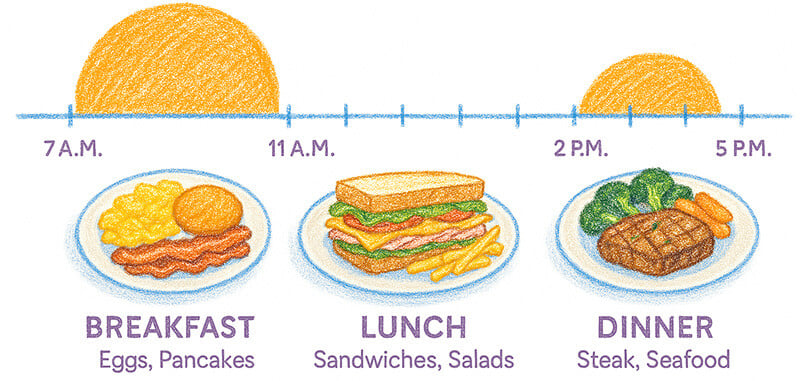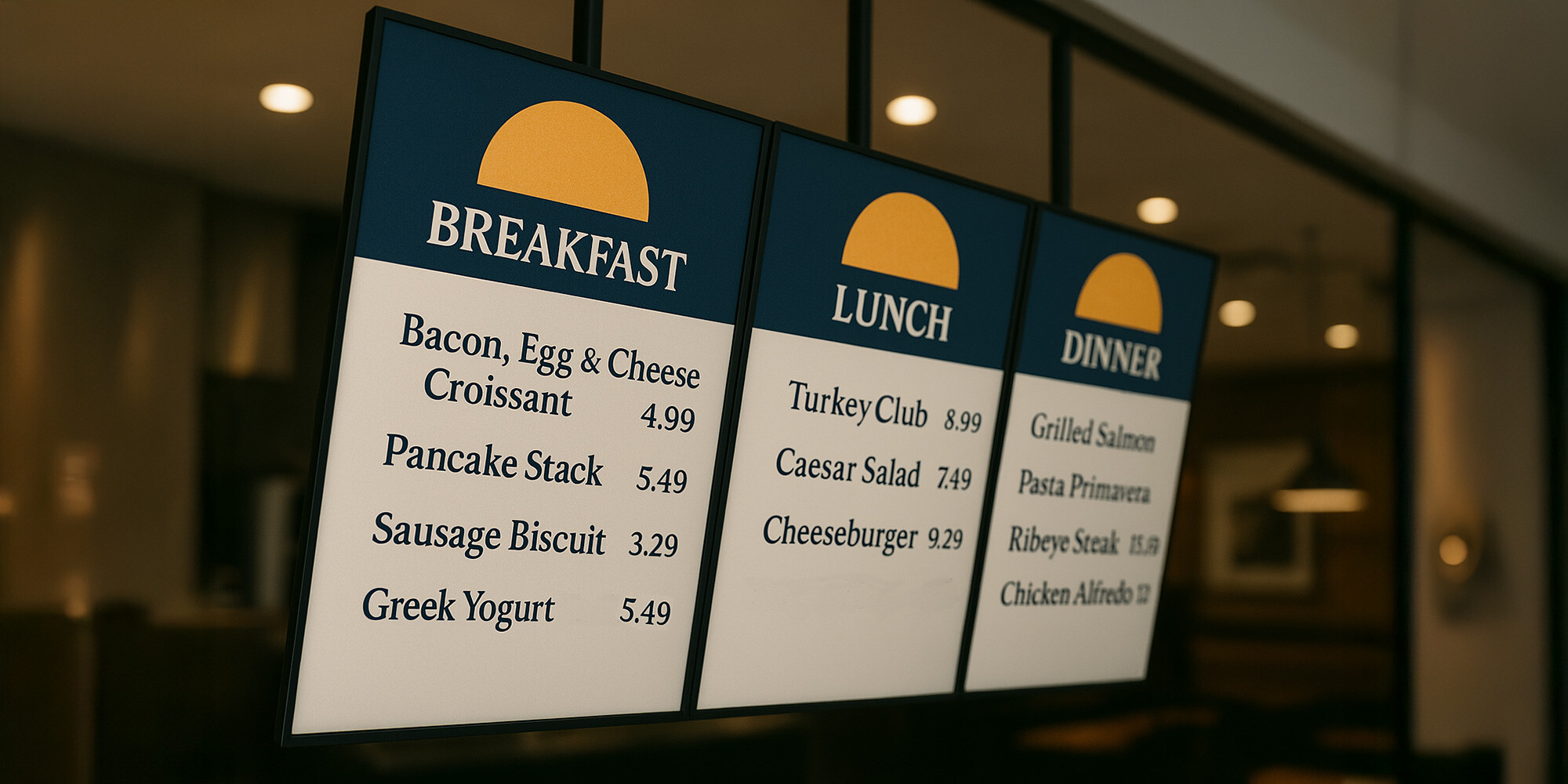Concept 3: The Potential of Daypart Optimization
Unlike static printed menus, digital menu boards offer the unique ability to automatically transition between different menu presentations throughout the day—aligning your offerings with changing customer needs, traffic patterns, and operational priorities as the hours pass. This dynamic capability isn't just a convenience feature; it's a strategic profit driver when properly implemented.
Understanding Daypart Menu Engineering
Daypart menu engineering is the strategic practice of customizing menu content, design, and pricing for specific times of day to maximize both customer satisfaction and profit potential. While traditional restaurants might offer separate printed menus for breakfast, lunch, and dinner, digital menu boards allow for more sophisticated approaches:
- Seamless transitions between dayparts without staff intervention
- Micro-daypart targeting for periods as short as 1-2 hours
- Dynamic emphasis of different items within the same menu
- Automatic promotional scheduling tied to specific times
- Data-driven optimization based on historical performance

The Business Case for Daypart Menu Engineering
The financial impact of proper daypart menu engineering can be substantial. Research by Sheryl E. Kimes published in the Cornell Hospitality Quarterly (2008) found that restaurants implementing daypart-specific menu strategies saw a 5-7% increase in revenue during slower periods. Effective strategies included product mix adjustments and pricing variations by time of day.
This improvement stems from several factors:
- Increased average check by featuring higher-margin items during appropriate dayparts
- Improved operational efficiency by highlighting items that can be produced quickly during peak periods
- Better inventory utilization by promoting items strategically throughout the day
- Enhanced customer satisfaction from presenting more relevant options
Core strategies and easy ways to implement them
Morning/Breakfast Daypart (Opening-11am)
The National Restaurant Association's 2021 State of the Industry Report found that morning customers are 37% more likely to add a beverage to their order when it's prominently featured alongside food items, rather than in a separate beverage section. So what does this mean for your menus? Simple... Visually connect a beverage to your breakfast items and watch your sales grow.
Implementation technique:
- Feature high-margin coffee drinks and breakfast beverages prominently
- Create breakfast combo opportunities that bundle high-margin beverages
- Use suggestive visual cues that pair foods with complementary drinks
Lunch Transition (10:30am-11:30am)
The lunch transition represents a critical operational challenge and opportunity. Research by King-Casey Restaurant Consulting published in FSR Magazine (2018) found that restaurants lose approximately 5-7% of potential customers during peak lunch periods due to perceived wait times, with menu board complexity being a significant contributing factor.
Implementation technique:
- Show a menu emphasizing items that can be prepared quickly
- Highlight lunch specials with simple decision paths
- Use visual cues that suggest efficiency (countdown timers, "express lunch" labeling)
Mid-day Lunch (11:30am-2pm)
The NPD Group's Foodservice Planning Program (2021) found that 62% of lunch customers prioritize value perception in their decision-making, significantly higher than dinner (47%) or breakfast (51%) dayparts.
Quick-service restaurants that highlight value-oriented combos during lunch see 22% higher combo attachment rates than those who don't.
Implementation technique:
- Feature prominently displayed combo meals with clear pricing
- Highlight value propositions explicitly ("lunch special pricing")
- Use side-by-side comparisons showing the savings of combo purchases
Afternoon Lull (2pm-5pm)
The afternoon period typically has lower traffic but presents opportunities for high-margin sales. Research by Hudson Riehle at the National Restaurant Association (2019) found that afternoon daypart customers are 23% less price-sensitive than lunch customers and more receptive to premium offerings.
Implementation technique:
- Shift emphasis to high-margin snacks, desserts, and specialty beverages
- Create afternoon-specific promotions with strong profit contributions
- Use more indulgent language and imagery during this period
Dinner Prime Time (5pm-8pm)
The National Restaurant Association's 2021 State of the Industry Report found that dinner customers spend an average of 21% more per person than lunch customers. This provides an opportunity to emphasize higher-margin items during this daypart.
Implementation technique:
- Highlight higher-priced premium entrées and shareable appetizers
- Create family bundle/meal deals prominent during evening hours
- Feature wine, cocktails, or other high-margin beverages appropriate for dinner
Late Night (After 8pm)
Research by Yang and Mattila published in the International Journal of Hospitality Management (2020) found that late-night customers (after 8pm) exhibit higher decision fatigue and respond 33% better to simplified menu presentations with fewer, more distinctive options compared to dinner customers.
Implementation technique:
- Reduce overall menu complexity during late hours
- Highlight high-margin items with strong visual appeal
- Emphasize shareable items and items that pair with alcoholic beverages
Technical Implementation on Digital Menu Boards
Scheduling and Transitions
Modern digital menu board systems offer robust scheduling capabilities. Key considerations for implementation include:
- Transition timing: Set transitions 15-30 minutes before actual daypart shifts to capture early arrivals
- Visual transitions: Subtle animation or movement during transitions can draw attention to menu changes
- Flexibility: Build in manual override capabilities for unexpected situations.
Managing Multiple Time Zones
For multi-location operations spanning different time zones, consider:
- Local timing: Program transitions based on local time rather than corporate time
- Regional customization: Adjust daypart timing based on regional traffic patterns
- Manual override: Allow location managers to temporarily adjust schedules as needed
Measuring Daypart Menu Engineering Success
Key Performance Indicators
To effectively evaluate your daypart strategy, track these metrics by time period:
- Average check by daypart
- Daypart-specific item mix percentages
- Attachment rates for targeted items
- Throughput during peak periods
- Profit contribution by hour
A/B Testing Approach
One of the greatest advantages of digital menu boards is the ability to conduct controlled tests:
- Single-variable testing: Change one element at a time to isolate impact
- Daypart rotation: Test different strategies by alternating days
- Location comparison: Test new strategies at select locations before full rollout
Common Pitfalls and How to Avoid Them
Operational Disconnect
The most sophisticated daypart menu strategy will fail if your operations can't execute it effectively.
Solution: Ensure kitchen staff is properly trained and equipped for each daypart transition. According to menu engineering expert Gregg Rapp, restaurants that implement formal daypart transition procedures on digital menu boards experience 24% fewer order errors during transition periods compared to those without formal procedures (Restaurant Business Magazine, 2020).
Confusing Transitions
Customers who arrive near transition times may be confused by changing menus.
Solution: Create clear visual cues for timing ("Breakfast served until 11am") and ensure staff is trained to handle requests that cross daypart boundaries.
Analysis Paralysis
With so much potential data, it's easy to get overwhelmed.
Solution: Start with your highest-volume daypart, establish clear baselines, make targeted changes, and measure results before expanding to other dayparts.
Your Daypart Engineering Action Plan
- Analyze current performance: Break down sales data by hour to identify patterns and opportunities
- Identify daypart-specific targets: Determine 2-3 key items to emphasize in each time period
- Design transitional strategies: Create clear plans for menu board changes between dayparts
- Implement and measure: Track key metrics across all dayparts
- Refine and expand: Systematically improve your approach based on results
In our next installment of the Digital Menu Board Mastery series, we'll explore real-time A/B testing strategies that allow you to continuously optimize your menu presentation based on actual customer behavior
Sources:
- Technomic Digital Menu Technology Report (2020). Future of Digital Menu Boards.
- Kimes, S.E. (2008). Managing Capacity Through Menu Design and Daypart Strategies in Restaurants. Cornell Hospitality Quarterly, 49(3), 302-309.
- National Restaurant Association (2021). State of the Industry Report.
- Nation's Restaurant News (2019). Starbucks Digital Menu Case Study.
- FSR Magazine (2018). King-Casey Restaurant Consulting: Reaping the Benefits of Menu Design.
- Smith, D., & Mittal, V. (2019). The Impact of Menu Design on Customer Behavior in QSR and Fast Casual Segments. Journal of Foodservice Business Research, 22(1), 65-82.
- The NPD Group (2021). Foodservice Planning Program.
- QSR Magazine (2018). McDonald's Digital Menu Board Implementation & Wendy's Digital Menu Strategy.
- Riehle, H., National Restaurant Association (2019). Consumer Daypart Preferences and Behaviors.
- Datassential (2020). Digital Menu Technology Report.
- Fast Company (2019). Taco Bell's Digital Menu Transformation.
- Restaurant Business Magazine (2020). Gregg Rapp: Menu Trends & Tech Solutions.
- Yang, S., & Mattila, A.S. (2020). Late Night Customer Behavior. International Journal of Hospitality Management.
- Digital Signage Today (2017). Chick-fil-A Digital Menu Board Implementation.
